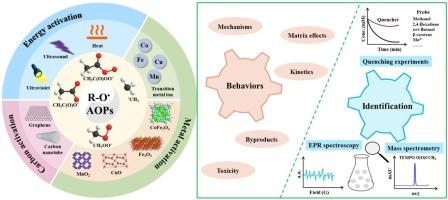过氧乙酸为基础的水净化高级氧化工艺中有机自由基化学的研究进展
IF 9
1区 工程技术
Q1 ENGINEERING, CHEMICAL
引用次数: 0
摘要
高级氧化工艺(AOPs)是公认的最先进的环境净化技术,利用产生高活性物质(RS)。然而,目前的综述主要针对常见的无机自由基和非自由基RS,往往忽略了有机自由基(R-O•)的关键作用,如乙酰氧基自由基(CH3C(O)O•)和乙酰过氧基自由基(CH3C(O)OO•)。与无机自由基(如羟基自由基)相比,R-O•表现出优越的选择性,更长的寿命,以及作为生物处理碳源或驱动聚合反应产生高附加值产品(如聚合物)的潜力,使R-O•介导的AOPs成为水处理中有希望的候选者。本文综述了过氧乙酸(PAA)基AOPs中R-O•化学的基本知识及其在水净化中的最新进展。首先,我们概述了R-O•的化学性质和生成机理。随后,从实际实施的角度系统地比较了它们在污染物降解中的氧化行为(包括动力学、机理、水基质效应、副产物形成和毒性)。此外,综述了R-O•的鉴定方法,并讨论了清除剂/探针的选择和实验结果解释方面存在的关键争议。未来的研究应优先明确R-O•的来源,而不是非均相催化剂,开发高灵敏度的原位检测技术和先进的R-O•调节策略,并对工程应用进行系统评估。这项工作提供了对paas基AOPs中R-O•的特征、反应性、生成和鉴定的基本理解,促进了它们在可持续环境修复中的作用。本文章由计算机程序翻译,如有差异,请以英文原文为准。


Critical review of organic radical chemistry in peracetic acid-based advanced oxidation processes for water decontamination
Advanced oxidation processes (AOPs) are recognized as state-of-the-art technologies for environmental decontamination, leveraging the generation of highly reactive species (RS). However, current reviews primarily address common inorganic radicals and nonradicals RS, often neglecting the critical role of organic radicals (R-O•) such as acetyloxyl radical (CH3C(O)O•) and acetyl peroxyl radical (CH3C(O)OO•). Compared to inorganic radicals (e.g., hydroxyl radical), R-O• exhibit superior selectivity, longer lifetimes, and the potential to serve as carbon sources for biological treatment or to drive polymerization reactions yielding high value-added products (e.g., polymers), rendering R-O•-mediated AOPs as promising candidates in water treatment. This critical review examines the fundamental knowledge of R-O• chemistry in peracetic acid (PAA)-based AOPs and their recent advancements in water decontamination. Firstly, we outline the chemical properties and generation mechanisms of R-O•. Subsequently, their oxidative behaviors (including kinetics, mechanisms, water matrix effects, byproduct formation, and toxicity) in pollutant degradation are systematically compared from a practical implementation perspective. Furthermore, the identification methods of R-O• are summarized and key existing controversies are discussed concerning the selection of scavengers/probes and the interpretation of experimental results. Future research should prioritize clearly elucidating R-O• origins over heterogeneous catalysts, developing highly sensitive in-situ detection techniques and advanced R-O• regulation strategies, and conducting systematic assessments for engineering applications. This work provides a foundational understanding of the character, reactivity, generation, and identification of R-O• in PAA-based AOPs, advancing their role in sustainable environmental remediation.
求助全文
通过发布文献求助,成功后即可免费获取论文全文。
去求助
来源期刊

Separation and Purification Technology
工程技术-工程:化工
CiteScore
14.00
自引率
12.80%
发文量
2347
审稿时长
43 days
期刊介绍:
Separation and Purification Technology is a premier journal committed to sharing innovative methods for separation and purification in chemical and environmental engineering, encompassing both homogeneous solutions and heterogeneous mixtures. Our scope includes the separation and/or purification of liquids, vapors, and gases, as well as carbon capture and separation techniques. However, it's important to note that methods solely intended for analytical purposes are not within the scope of the journal. Additionally, disciplines such as soil science, polymer science, and metallurgy fall outside the purview of Separation and Purification Technology. Join us in advancing the field of separation and purification methods for sustainable solutions in chemical and environmental engineering.
 求助内容:
求助内容: 应助结果提醒方式:
应助结果提醒方式:


